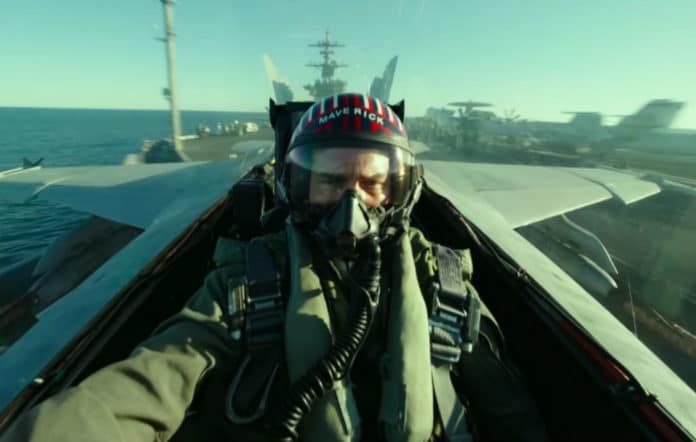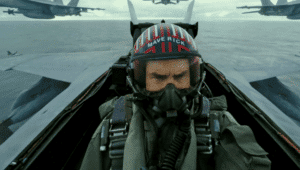Aerospace
How did Top Gun shoot the movie in a US Navy fighter jet, and how much did it cost?

Top Gun Maverick is currently playing in theatres, and tome Cruise, who is famed for his amazing stunts and action, plays the lead part in this picture. The film was scheduled to be released in 2018, however it was postponed due to the epidemic. Another feature of the film is the F/A 18 fighter jet, which is now serving in the US Navy.
It was difficult to shoot the video with the F/A 18 since the US Pentagon has prohibited the use of defense assets for non-military purposes. The film’s creation has cost a fortune in order to persuade the US Pentagon.
To be able to replicate in the film reel, the Top Gun team has gone through intensive training. In essence, they underwent deep water training in the event of an emergency and received basic instruction in the L-39 aircraft. Since the F/A 18 is the fastest fighter jet, it possesses a high G force. The cast and crew have put forth a lot of effort to get that serious expression in the performing.
Tom Cruise was given F/A-18 Super Hornets by the US Navy for the next “Top Gun” film. The only catch: the studio paid up to $11,374 per hour to use the powerful fighter planes, and Cruise was not allowed to operate them.
The “Mission Impossible” star, who is known for executing his own stunts, requested that all of the actors playing pilots in the long-awaited “Top Gun: Maverick” picture fly in one of Boeing Co.’s fighter jets to get a sense for what it’s like to fly under the strain of massive gravitational forces.
Airbus demonstrates first fully automatic vision-based take-off
Cruise, 59, had previously flown in a jet for the 1986 smash hit “Top Gun.” According to Glen Roberts, the chief of the Pentagon’s entertainment media office, a Pentagon law prohibits non-military persons from managing a Defense Department equipment other than small weapons in training scenarios. Cruise flew more than a dozen sorties for the new film. Instead, after completing essential training on how to eject from the jet in an emergency and how to survive at sea, the actors rode alongside F/A-18 pilots.
Cruise established his own tough flight training programme for the film’s teenage actors, according to production notes, so that they could survive the nausea-inducing rigours of aerial maneuver’s and execute their roles with “actual Navy pilots taking them on the ride of their lives.”
Facts Pilots Don’t Want You To Know…!!
After being delayed owing to the coronavirus outbreak, the film is finally being released this week. According to Roberts, the scenes were shot onboard the USS Abraham Lincoln during a training exercise with the military’s F-35C Lightning II fighter plane in August 2018. In Central California, the project also filmed at Naval Air Station Lemoore.
The film is doing well over the world, and it is expected to break all box office records. It’s a coincidence that the picture came out right before the Indian Navy’s contract negotiations. There will be less of a political game to decipher the intent, but enjoy the film nonetheless. Tell us whether you saw the movie and what you thought of it in the comments area.
Why is China concerned about the Ka 52 being shot down?

Aerospace
Which is bigger 777x or 787 aircraft ?

The 777X is a new series of the Boeing 777 family and is designed to be larger and more efficient than its predecessor. It features two variants: the 777-8 and the 777-9, being the larger of the two.
The Boeing 777X emerges as the larger sibling within the Boeing family, representing a significant leap forward in both size and efficiency. Comprising two variants, the 777-8 and the 777-9, the latter takes the crown as the larger of the two. With its expansive fuselage and impressive wingspan, the 777X is tailored for long-range journeys and boasts a substantial passenger capacity.
On the other hand, the Boeing 787, affectionately known as the Dreamliner, occupies a niche in the market as a smaller yet formidable aircraft designed for medium to long-range flights. Its distinguishing feature lies in its composite fuselage, a technological marvel that renders it lighter and more fuel-efficient compared to conventional aluminum counterparts. The Boeing 777X is larger than the Boeing 787 aircraft.
When it comes to passenger capacity, the 777-9 reigns supreme, typically accommodating a sizeable contingent of 400-425 passengers in its standard configuration. In contrast, the 787, with its more modest dimensions, typically carries between 240-290 passengers, depending on the variant and layout.
One of the remarkable innovations introduced with the 777X is its folding wingtips, a feature designed to address the logistical challenges of accommodating such a large aircraft in conventional airport gates. These folding wingtips enable the 777X to retract its wings, allowing it to fit into gates designed for smaller aircraft while still reaping the benefits of an extended wingspan during flight, thereby enhancing fuel efficiency and operational flexibility
Aerospace
China Secures Production Certificate for Mass Production of Pilotless eVTOL Aircraft

The first passenger-carrying pilotless electric vertical takeoff and landing (eVTOL) aircraft in the world, the EH216-S, has received the Production Certificate for its eVTOL aircraft from the Civil Aviation Administration of China (CAAC).
This is a significant milestone for EHang Holdings Limited, the leading UAM technology platform company in the world. This outstanding accomplishment is another big step towards mass manufacturing for the eVTOL aircraft and the ensuing commercial operations, building on the ground-breaking acquisition of the Type Certificate and the Standard Airworthiness Certificate for the EH216-S.
The PC is a crucial certificate that the aircraft maker receives from the CAAC, the country’s aviation authority. By obtaining this certificate, EHang has demonstrated that it has set up a quality management system for mass production that satisfies the airworthiness regulation standards set forth by the CAAC, and the company has been given permission to continue producing mass quantities.
It is also a strong guarantee of the calibre of the goods made by EHang. Raw materials, supplier management, manufacturing organisation, production quality control, aircraft pre-delivery test, after-sales repair and maintenance, etc. are all included in the mass production quality management system for the EH216-S.
To ensure that every aircraft and its components that roll off the production line strictly adhere to the approved type design and safety requirements, the system sets clear guidelines and documentation for every step in the production procedure. This ensures comprehensive traceability and safety control.
Aerospace
Four Airbus A380 Superjumbos lined up to be scrapped

In a strategic move aimed at reclaiming valuable resources from the iconic Airbus A380 aircraft, VAS Aero Services and Dr. Peters Group have announced a significant collaboration.
This partnership marks a milestone in aviation logistics and aftermarket services, with four of these colossal planes slated for teardown and redistribution of used serviceable material (USM).
The venture between VAS Aero Services, renowned for its expertise in aircraft dismantlement, and Dr. Peters Group, a prominent Germany-based investment fund management firm, underscores a commitment to sustainable aviation practices. This isn’t their first foray into scrapping A380s; their successful partnership has already seen the dismantlement of these aircraft, making them pioneers in this niche.
Under the agreement, the latest consignment brings the tally to eight A380s entrusted to VAS by Dr. Peters Group. Managing Director Christian Mailly of Dr. Peters Group emphasized the trust placed in VAS, citing their unparalleled capabilities in dismantlement and aftermarket sales network. It’s a strategic move in response to the growing demand for quality USM parts, particularly with the resurgence in reliance on the A380.
Notably, the teardown process will be carried out at various locations, optimizing the positioning of harvested parts to cater to different markets. While some parts will be positioned in Europe to support operators in the region and the Middle East, others will remain in the Asia-Pacific region. This meticulous strategy ensures efficient access to spare parts, benefiting MROs and airlines across these markets.
The decision to retire these A380s comes at a time when operators are reassessing fleet strategies amidst evolving market dynamics. Despite initial plans for quick retirement due to the emergence of more fuel-efficient alternatives, factors such as a rebound in long-haul demand and delays in new widebody deliveries have prompted operators to reconsider. The A380, with its unique capacity and capabilities, presents a practical solution for short-term capacity management.






















